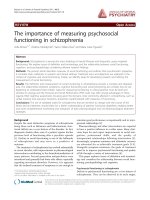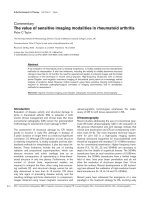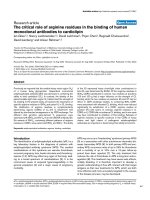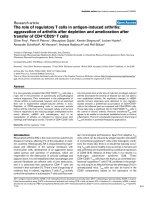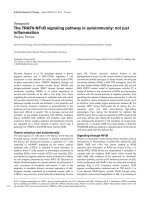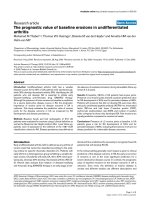Báo cáo y học: "The International Sepsis Forum’s controversies in sepsis: how will sepsis be treated in 2051" ppsx
Bạn đang xem bản rút gọn của tài liệu. Xem và tải ngay bản đầy đủ của tài liệu tại đây (27.93 KB, 3 trang )
NF-κB = nuclear factor-κB.
Available online />I do not think there will be something called ‘sepsis’ in 2051
because we will know much more about this entity than we
do at present. Patients will still present in the same way
(clinical evidence of infection with or without organ failure)
but we will be able to determine very quickly (using
polymerase chain reaction or other techniques) which
organism the patient has been infected with, and hence the
antimicrobials to use. We will also rapidly identify which
pathways are activated in patients. Therefore, instead of
discussing a syndrome (which is the problem with sepsis at
the present time), we will be able to state which organism the
patient is infected with and we will know why they have (or
why they are likely to have) organ failure.
In 2051 we will not be talking about syndromes but rather
about molecular definitions of and genetic predisposition to
disease, as well as about activation of specific pathways that
lead to organ dysfunction. Therefore, although two patients
lying in beds next to each other may look alike, in fact
completely different pathways may be activated in them, and
we will be able to recognise this. We will therefore move from
vague diagnoses to specific descriptions of the patient’s
condition. For example, the oncologist may say that ‘The
patient has a B-cell lymphoma with a transposition of a certain
chromosome’, rather than simply stating that a patient has
cancer; in 2051 we will be able to make an equally specific
statement, enabling us to provide specifically targeted therapy.
Lessons from nuclear factor-
κκ
B
One of the great advances over the past few years has been
to elucidate the pathway that leads from Toll-like receptors to
the acute inflammatory response by activating certain genes.
This, of course, eventually leads to organ system dysfunction,
and the prime candidates for activating these genes are
transcription factors. One that is known to activate multiple
proinflammatory genes is nuclear factor-κB; we know that
patients who have greater activation of NF-κB tend not to
survive.
Commentary
The International Sepsis Forum’s controversies in sepsis: how
will sepsis be treated in 2051?
Edward Abraham
Head, Division of Pulmonary Sciences and Critical Care Medicine, University of Colorado Health Sciences Center, Denver, Colorado, USA
Correspondence: Edward Abraham,
Published online: 10 June 2002 Critical Care 2002, 6:277-278
This article is online at />© 2002 BioMed Central Ltd (Print ISSN 1364-8535; Online ISSN 1466-609X)
This article is based on a presentation at the 31st Annual Congress of the Society of Critical Care Medicine (SCCM), San Diego, California, USA,
26–30 January 2002. The presentation was supported by the International Sepsis Forum (ISF).
Abstract
Great advances have been made in describing the intracellular pathways and genes that are activated
by bacterial products. New definitions and therapies for sepsis will be based on such cellular and
genetic alterations. In particular, in 2051 sepsis will no longer be defined simply as a clinical
constellation of findings, but rather will be divided into different entities dependent on the intracellular
cascades or genes activated. Similarly, therapies will be specifically directed at such functional genetic
or biochemical alterations, thereby permitting more rational therapy of specific cellular abnormalities in
infected patients. Supportive care will also have advanced by 2051, allowing for less iatrogenic harm
to critically ill septic patients. Finally, a better appreciation of the cellular and genetic pathways that are
activated in patients will permit an improved understanding of prognosis in critically ill infected patients,
allowing more appropriate use of therapies.
Keywords genomics, nuclear factor-κB, proteomics, sepsis
Critical Care August 2002 Vol 6 No 4 Abraham
Unfortunately, in 2051 we will still have to deal with
endotoxin being released by Escherichia coli, but by then we
will be able to determine who will do poorly and who will do
well. By appreciating the patient’s gene polymorphisms,
including single nucleotide polymorphisms, we will know how
they will react to endotoxin, because we will have deduced
which of those polymorphisms leads to higher or lower
expression of the molecules associated with organ
dysfunction. Therefore, we will be able to identify at-risk
patients early and treat them accordingly.
Remember, however, that it is not enough just to turn on
genes; they must also be translated into proteins. By 2051
we will have developed techniques that will tell us within
several hours, or even minutes, what pattern of proteins a
patient has. Some recent data from my laboratory illustrate
what happens when neutrophils are stimulated from a group
of volunteers with lipopolysaccharide. We found that there
are both high and low responders, with high responders
being those who consistently produced more NF-κB and the
low responders being those who barely reacted to the
endotoxin.
Therefore, the central dogma of this new field will probably
be to gain an understanding of how proteins are expressed,
because these are really the motors of cellular function and
dysfunction in critically ill patients. DNA reflects our genomic
predisposition and there will be changes in RNA that we can
detect with chips, but what is probably most important is how
proteins are expressed.
Detection
At present we can describe a patient’s genetic make-up by
looking at several thousand cells. However, the number of
cells required has been dropping dramatically, and by 2051
we will need fewer than 10 cells (which could be achieved
from a buccal rub) to determine a patient’s genomic
predisposition. This will tell us which genes are upregulated
and which genes are downregulated. Currently, such
procedures take hours, but without a doubt in the near
future, and certainly before 2051, we will be able to do this
in a similar time as routine laboratory tests require.
Therefore, when a patient presents in the emergency
department, we will be able to tell their genomic profile both
quickly and easily.
Interesting though that may be, and as I allude to above, the
real issue is to be able to assess the patient’s proteomics. By
2051 we will be able to identify which proteins are being
expressed, to what levels, how high or how low the protein
levels are in various cell types, and how the proteins are
modified after translation. This will enable us to identify those
patients who will respond to various drugs. For example, if a
patient upregulates the intracellular kinase Akt and has
increased levels of this kinase, then we will be able to give
them an anti-Akt therapy and thus improve their outcome.
Long before 2051 we will have created a database of
proteins by taking them out of the cells, running them in a
two-dimensional gel, visualizing the gel using an informatics
system, and deducing which spots are upregulated proteins.
As and when we find a previously unidentified spot we can
sequence it using mass spectroscopy and therefore identify
the protein. All this will be put into a database so that we will
know what a pattern of proteins means in terms of disease
severity and prognosis. Thus, by 2051, just as a blood
transfusion may be given for a low hematocrit, we will know
from the spots on the gel what the patient has in terms of
their molecular disease and how to treat them.
Supportive care
Even if we do not have ‘sepsis’ and even if therapies are
based on molecular mechanisms and signaling pathways,
there will still be a role for supportive care. Some patients will
be noncompliant and will present with relatively advanced
disease and organ dysfunction. For these patients we will
have to modulate activated pathophysiologic cascades that
contribute to organ system dysfunction and death.
Our supportive care will be nontoxic. Tidal volumes are
currently getting smaller and smaller, and by 2051 we will
have no tidal volume ventilation; we are getting close to that
now. We will have noninvasive monitoring of organ and
cellular function, and so catheters will no longer be needed.
We will have maintenance of tissue homeostasis through
appropriate metabolic, nutritional, and cellular support. We
will also have more accurate outcome prediction, leading to
appropriate levels of support.
By being able to identify cascades and intercellular
mechanisms, we will also be able to identify those patients in
whom it does not make any sense to intervene. Through
prophylactic care we will be able to increase how long our
patients live, as well as improving their quality of life. If and
when the patient suffers a catastrophic event we will look at
the intercellular picture and make one of two choices; either
the patient is amenable to therapy or this is a terminal event.
The patient will have lived a long and healthy life because of
prophylactic therapies; they will have received gene therapy,
because their genetic polymorphisms will have been
identified; and they will have received appropriate vaccines –
at this point there is nothing else that can be done. At this
point we will still need to talk to families – we are still
physicians, we are still health care providers, and we will be
better able to inform the family about the prognosis and to
better tailor and choose therapies at that time.
Competing interests
PST received an honorarium from the International Sepsis
Forum for helping to write this commentary.
Acknowledgements
I thank Pritpal S Tamber for his assistance in writing this commentary. I
also thank the International Sepsis Forum (ISF) for inviting me to partic-
ipate in this debate during the Society of Critical Care Medicine
(SCCM) Annual Congress in San Diego, USA, in January 2002. For
more information about the ISF, see .
Available online />

